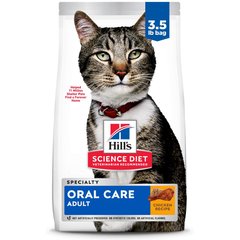Stomatitis in Cats: Symptoms, Causes and Treatment
Nils Jacobi/iStock / Getty Images Plus via Getty Images
What Is Stomatitis in Cats?
Stomatitis in cats is a complex, painful, and frustrating disease that causes severe inflammation of the entire mouth, including the gingiva (gum tissue around the teeth) and mucous membranes.
Stomatitis in cats—often called feline chronic gingivo-stomatitis (FCGS) by veterinary dentists—affects up to 10% of cats.
Gingivitis vs. Stomatitis in Cats
Gingivitis only affects the gingiva—or gumline—where the tooth meets the mucus membrane of the gums.
Stomatitis in cats is a much more severe form of inflammation in the mouth and involves more than just the gingiva.
Stomatitis can affect the gums, lips, tongue, the roof and the floor of a cat’s mouth.
While most cases of gingivitis in cats are tolerated, stomatitis is painful and debilitating.
Symptoms of Stomatitis in Cats
The first symptom of stomatitis in cats is a foul odor coming from your cat’s mouth.
This may be accompanied by excessive salivation/drooling, or you may notice that your cat is not grooming themselves as much which can lead to matted fur.
You might also see your cat dropping food from their mouth or crying out while eating. Some cats become so painful they become hesitant to eat and may avoid food to the point that they start losing weight.
What Causes Stomatitis in Cats?
The cause of stomatitis in cats is unknown.
Veterinarians do know that there is an abnormal immune system response that leads to stomatitis.
It’s most likely an exaggerated response to a virus or bacteria and plaque on the teeth, but the exact cause of that response remains a mystery.
How Vets Diagnose Stomatitis in Cats
Veterinarians diagnose stomatitis in cats primarily by doing a thorough oral examination.
Severe inflammation of the gums along with severe inflammation of the inside of the cheeks and the back of the mouth is usually diagnostic for stomatitis.
Systemic metabolic disease should be ruled out with baseline blood work and urine testing.
Your vet will also want to do a viral screening for conditions like feline immunodeficiency virus (FIV) and feline leukemia virus (FeLV)which contribute to stomatitis in cats.
Depending on how severe your cat’s stomatitis is, if the lesion is in a specific area, a biopsy might be needed to rule out a local infection or even oral cancer.
Many patients also experience tooth resorption and inflammation of the bone around the teeth (periodontitis) at the same time as evident on dental X-rays.
Stomatitis in Cats Treatment
Successful treatment of stomatitis in cats requires minimizing bacteria in the cat’s mouth as much as possible.
This is rarely achieved through at-home dental care or anesthetized cleanings alone. Even a small number of bacteria or plaque can be seen in cats with severe stomatitis.
In fact, cats with stomatitis often have severe inflammation that does not resolve or quickly returns after a thorough dental cleaning by their veterinarian.
The current recommended treatment is partial or full-mouth tooth extraction surgery.
While this may seem to be a drastic measure, it’s currently the best way to achieve substantial and long-term comfort for cats with stomatitis.
This can be an extensive surgery, and your veterinarian may recommend a consultation with or referral to an American Veterinary Dental College specialist (a veterinary dentist).
Recovery and Management of Stomatitis in Cats
Studies have shown that 90% of cats that undergo partial, or full-mouth tooth extractions have shown complete resolution of their stomatitis symptoms.
For cats that eat hard kibble, they should be transitioned to canned food before surgery with a plan to remain on a softened diet for at least two to three weeks post-op.
For cats that are hesitant to eat during the first few days after surgery, your veterinarian can prescribe an appetite stimulant. Your veterinarian will also provide medications for you to take home for post-surgical pain and inflammation.
Once the gum tissue has healed, many cats are willing and able to eat kibble again.
Pet parents often see quick improvement in their cat’s attitude, appetite, and quality of life once their mouth is free from the pain and inflammation of stomatitis.
Prevention of Stomatitis in Cats
In most cases, stomatitis in cats is difficult to prevent because the exact cause is unknown.
The most effective way to provide your cat with the best oral health is with routine cleanings.
You’ll need to brush your cat’s teeth daily with a cat-specific toothpaste at home and bring your fur baby in for regular dental cleanings with their veterinarian.
This can help to prevent excessive bacterial build up that may contribute to the development of stomatitis in some cats.
There are also special dental diets—such as Hill’s® Science Diet Oral Care—that help reduce plaque and tarter buildup. These diets also provide nutrients like antioxidants which help to support a healthy immune system.
Stomatitis in Cats FAQs
Can you treat stomatitis in cats at home?
Unfortunately, once stomatitis in cats develops it likely can’t be treated at home.
Is stomatitis contagious in cats?
Most cases of stomatitis in cats are not contagious since it’s an alteration to a cat’s individual immune system.
In some cases—where a virus is involved in the development of stomatitis—it can be contagious from one cat to another.
Is stomatitis in cats deadly?
Severe cases of stomatitis in cats can be deadly especially if a cat is in extreme pain.
Pain in cats often leads to anorexia, which can cause liver failure in cats. This form of liver disease, hepatic lipidosis, is fatal in most cases even with aggressive treatment.
Stomatitis in cats can also be caused by certain viruses which can be fatal if not treated aggressively early on.
References
Lommer MJ. Efficacy of cyclosporine for chronic, refractory stomatitis in cats: a randomized, placebo-controlled, double-blinded clinical study. J Vet Dent. 2013; 30(1):8-17.
Hennet P. Feline chronic gingivostomatitis: Extraction and what else? Veterinary Dental Forum. 2010.
Hennet P. Chronic gingiva-stomatitis in cats: Long-term follow-up of 30 cases treated by dental extractions. J Vet Dent. 1997;14(1):15-21.



